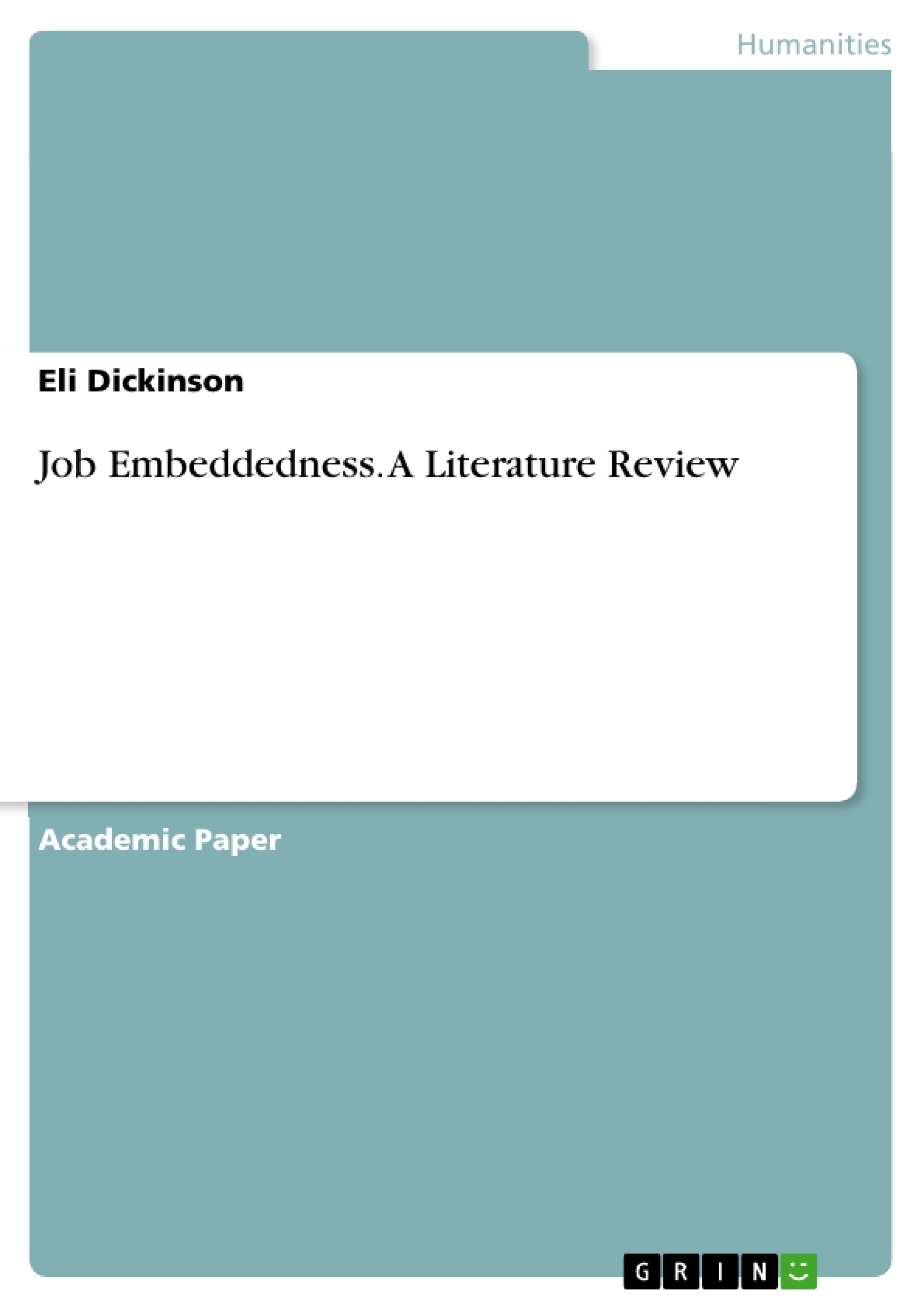The purpose of this literature review is to examine the construct of job embeddedness. Job embeddedness is a construct first developed by Mitchell et al (2001) to better explain employee turnover. Job embeddedness is described as the forces that keep an individual in their job. Over the years this construct has been researched and used to explain other beneficial employee behaviors (e.g. organizational citizenship behaviors). This review will bring to light the historical and theoretical background of job embeddedness will be discussed. Along with this, this review will define job embeddedness and conceptually differentiate it from similar constructs. Next, common antecedents of job embeddedness will be described. Fourth, this review will discuss the many different effects of job embeddedness has on organizations and work behavior. After that, there will be a further conceptual discussion about job embeddedness as both a mediating and moderating variable. Finally, a section on future directions for job embeddedness research will be presented.
Table of Contents
- Abstract
- Introduction
- Historical and Theoretical Background
- Defining Job Embeddedness
- Antecedents of Job Embeddedness
- The Impact of Job Embeddedness on Organizations
- Job Embeddedness: A Mediator and Moderator
- Conclusion and Future Directions
- References
Objectives and Key Themes
This literature review aims to comprehensively examine the construct of job embeddedness, initially developed to explain employee turnover but subsequently shown to influence other work behaviors. It explores the historical and theoretical underpinnings of the concept, provides a clear definition, and differentiates it from related constructs. The review also investigates the antecedents of job embeddedness and its impact on organizational outcomes.
- Historical and theoretical foundations of job embeddedness
- Definition and differentiation of job embeddedness from similar constructs
- Antecedents that contribute to job embeddedness
- Impact of job embeddedness on organizational performance and employee behavior
- Job embeddedness as a mediating and moderating variable
Chapter Summaries
Introduction: This chapter introduces the concept of job embeddedness, highlighting the historical focus on employee turnover research and the shift towards understanding why employees stay. It emphasizes the groundbreaking contribution of Mitchell et al. (2001) in introducing job embeddedness as a framework for explaining employee retention. The chapter also previews the subsequent sections of the review, outlining the exploration of the theoretical background, definition, antecedents, organizational impacts, mediating and moderating roles, and future research directions of job embeddedness.
Historical and Theoretical Background: This section traces the origins of job embeddedness theory, connecting it to Kurt Lewin's Field theory and the unfolding model of turnover. It explains how Lewin's concept of life space, encompassing environmental factors influencing behavior, relates to the forces that keep individuals embedded in their jobs. The chapter then discusses the unfolding model, which posits that turnover is not solely driven by dissatisfaction or better job opportunities, but also by "shocks" that trigger reconsideration of the job. Finally, it introduces Conservation of Resources (COR) theory, explaining how job embeddedness functions as a resource caravan that employees strive to protect and enhance, influencing their motivation and behavior.
Keywords
Job embeddedness, employee turnover, organizational citizenship behavior, Conservation of Resources theory, Lewin's Field theory, unfolding model of turnover, links, fit, sacrifice, organizational commitment.
Frequently Asked Questions: A Comprehensive Language Preview on Job Embeddedness
What is the purpose of this literature review?
This literature review comprehensively examines the construct of job embeddedness. It explores its historical and theoretical underpinnings, provides a clear definition, differentiates it from related constructs, investigates its antecedents, and analyzes its impact on organizational outcomes. The review also examines its role as a mediating and moderating variable.
What are the key themes explored in this literature review?
Key themes include the historical and theoretical foundations of job embeddedness; a precise definition and differentiation from similar constructs; antecedents contributing to job embeddedness; the impact of job embeddedness on organizational performance and employee behavior; and job embeddedness's role as a mediating and moderating variable.
What is the historical and theoretical background of job embeddedness?
The review traces the origins of job embeddedness theory, connecting it to Kurt Lewin's Field theory and the unfolding model of turnover. It explains how Lewin's concept of life space relates to the forces keeping individuals embedded in their jobs and discusses the unfolding model's perspective on turnover triggers. The Conservation of Resources (COR) theory is also introduced, explaining job embeddedness as a resource employees strive to protect and enhance.
How is job embeddedness defined and differentiated from similar constructs?
The review provides a clear definition of job embeddedness and distinguishes it from related constructs, although the specific details of these differentiations are not included in this preview.
What are the antecedents of job embeddedness?
The review investigates the factors that contribute to job embeddedness, although the specific antecedents are not detailed in this preview.
What is the impact of job embeddedness on organizations and employee behavior?
The review explores how job embeddedness affects organizational performance and employee behavior. While specific impacts aren't detailed here, the preview suggests this is a major focus.
What is the role of job embeddedness as a mediating and moderating variable?
The review examines job embeddedness's function as a mediating and moderating variable in various organizational processes. Specific examples and details are not provided in this preview.
What are the key chapters included in this literature review?
The review includes chapters on: Abstract, Introduction, Historical and Theoretical Background, Defining Job Embeddedness, Antecedents of Job Embeddedness, The Impact of Job Embeddedness on Organizations, Job Embeddedness: A Mediator and Moderator, Conclusion and Future Directions, and References.
What are the keywords associated with this literature review?
Keywords include: Job embeddedness, employee turnover, organizational citizenship behavior, Conservation of Resources theory, Lewin's Field theory, unfolding model of turnover, links, fit, sacrifice, and organizational commitment.
What is the overall conclusion and future research directions?
The preview states that the conclusion and future research directions are included in the full text, but those details are not given here.
- Quote paper
- Eli Dickinson (Author), 2020, Job Embeddedness. A Literature Review, Munich, GRIN Verlag, https://www.hausarbeiten.de/document/1194037


